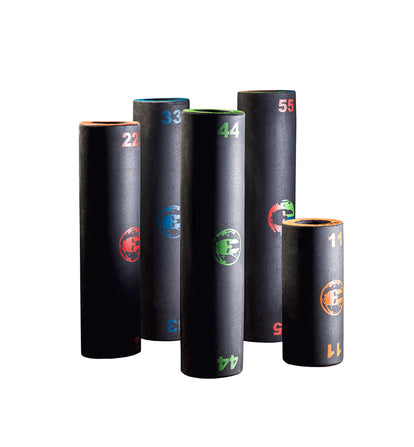Foam Rolling Techniques That Build Muscle Mass

Foam rolling is incredibly common for athletes to use to loosen their muscles at the start of a workout or enhance their recovery at the tail-end of training. But an effective self-myofascial release (SMR) technique (the technical term for foam rolling) shouldn’t just be viewed as an addition to a warm-up or a cool-down — it’s also essential for building muscle.
Let’s be clear, though. A workout consisting solely of foam rolling will not earn you the shredded quads required to climb any mountainous courses, nor the sheer strength to swing effortlessly from obstacles. But what it can do, as Spartan SGX coach Sean Hastings explains, is relieve some tightness and tenderness that you might feel in your muscles pre- or post-workout, and allow greater efficiency in your next training session. This, in turn, will help to build lean muscle mass.
Related: 3 Foam Rolling Techniques That Will Help You Naturally Sleep Better
“Our muscles, tendons, and other tissues are surrounded by fascia, and this fascia can get all bound up, particularly in training — think crumpled-up like plastic wrap,” Hastings, owner of Spartan-focused Revolution Fitness, says. “This contributes to pain, reduces flexibility, and prolongs recovery.
"When you foam roll, you're flattening the fascia back to normal. This process reduces pain, helps increase flexibility, and speeds up recovery.”
It’s during recovery that muscles have time to strengthen and grow. An accelerated recovery process not only supports this, but can directly enhance the quality of your workouts as well. How? By enabling you to return to your workouts with muscles that are repaired, relaxed, and with a healthy range of motion.
The Science Behind Foam Rolling

Studies have shown that foam rolling can minimize delayed-onset muscle soreness (DOMS). This not only allows you to get back to training quicker, but because you’ve conquered your pain, you can boost your actual performance.
Related: 6 Ways Infrared Sauna Use Optimizes Health, Training, and Recovery
Another comprehensive review published in the International Journal of Sports Physical Therapy explains how foam rolling stimulates short-term increases in range of motion, which contributes to an increase in muscle flexibility. This, again, promotes more efficient workouts.
Tricking Your Nervous System Into Relieving Pain
But foam rolling might not just be about ironing out the fascia knots. It's possible that what's actually going on is a combination of myofascial release and neurological changes occurring within the muscles. Hastings notes that actual nerve receptors in an achy area might be stimulated through foam rolling.
“If the area is particularly painful, it’s good to keep the roller right there," he says. "After a short period, the pain will subside and you may even feel a release."
This release is likely caused by the pressure of the foam roller telling the nervous system to reduce pain signals from the muscle. But however foam rolling works to reduce tightness and ease pain, the bottom line is that it does work. And in doing both, it can also help to reduce muscle imbalances, which — besides messing with your ability to build strength — can also lead to reduced mobility, instability, and even injury.
Related: 3 Foolproof Ways to Recover Quickly During Multi-Race Weekends
So, what are the best foam rolling exercises to not only maintain muscle balance but to build it, too?
Truthfully, as Hastings says, it’s best to target wherever the pain and tightness are hitting before or after a workout. But a few places that you should always work on to ensure a full range of motion (and therefore an optimal chance of building lean muscle) include your hips, calves, quads, and spine. Here are a few simple ways to start.
Foam Rolling Exercise for Hips
- Place a foam roller on the ground.
- Lie over it facing downward, and position the roller just below the crease of one of your hips.
- Angle the opposite leg out to the side by 45-90 degrees. You’ll use this leg to apply pressure to the opposite side.
- Leaning on your elbows and forearms, roll back and forth on the foam roller, staying just below the hip crease.
- Keep your weight on your toes, hands, and the foam roller.
- Repeat on the opposite side.
Foam Rolling Exercise for Calves
- Work on one leg at a time.
- Place the roller under your lower leg and sit flat on the ground. Using the opposite leg and both arms planted with your hands down on either side of you, push your body off of the ground.
- As you’re doing this, put pressure on the calf that you’re trying to work on.
- Repeat on the opposite side.
Foam Rolling Exercise for Quads
- Lie face down with a foam roller under your left thigh and above your knee.
- Using your arms and your right leg, begin to move your body up and down at least three or four times. Stop halfway up your left thigh as you do this.
- Then, as comfortably as you can, bend your left leg back and forth slowly so that you’re bringing your left heel close to your butt.
- Following this, roll up to the top of the thigh and back three or four times.
- Repeat on the opposite side.
Foam Rolling Exercise for Spinal Alignment
- Place the roller horizontally across your upper back, just below your shoulder blades.
- Bend your knees and place your feet firmly on the floor.
- Interlace your fingers at the base of your skull and lean backward.
- Raise your hips slightly to move the roller up toward your shoulders.
- Focus on sensitive areas for at least 30 seconds.
-
Work your way up to your shoulders, then work your way down to your mid-back again. Try not to move the roller lower than your mid-back area.

